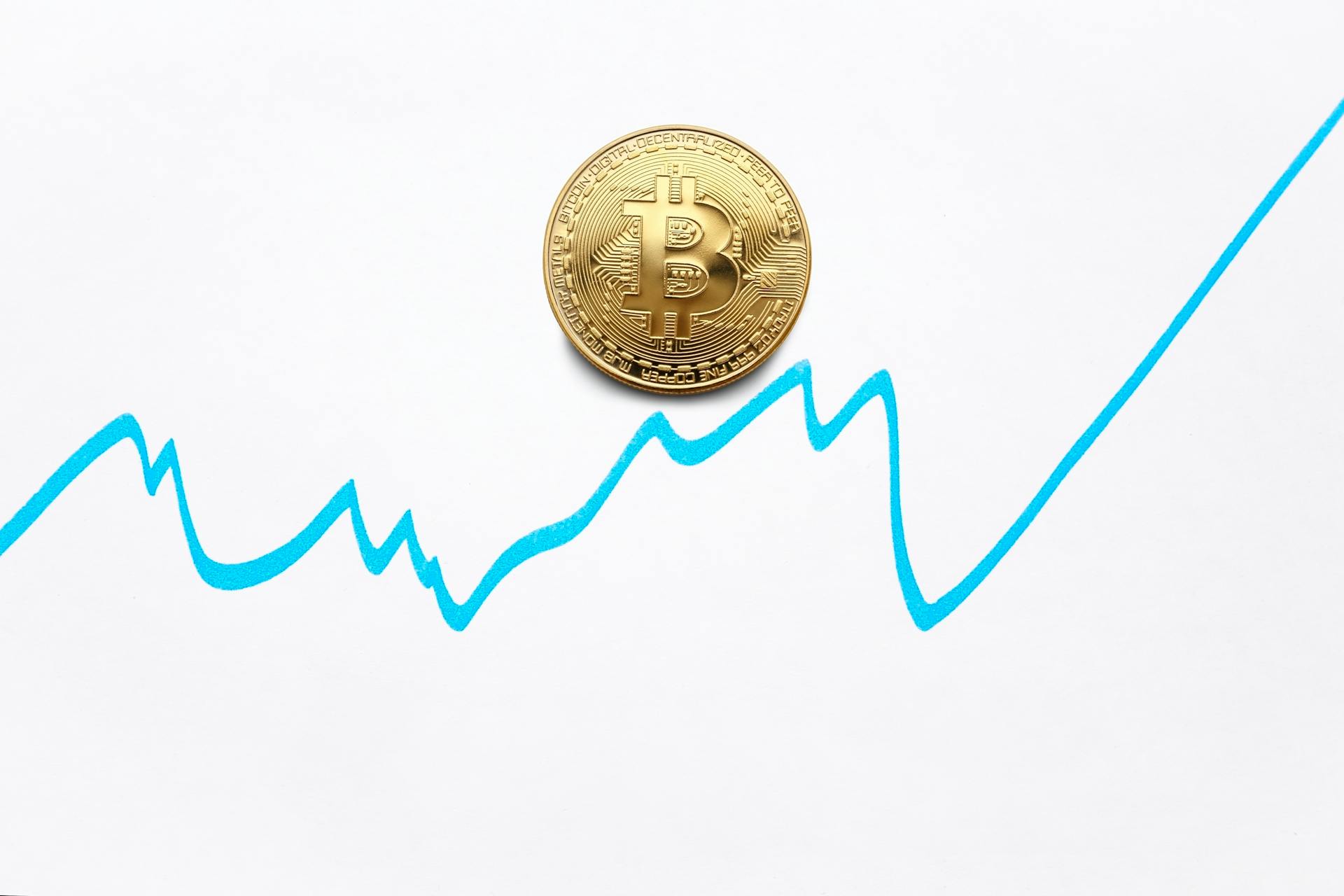
Entropic Value at Risk is a risk management tool that's gaining popularity in the finance world. It's a more nuanced approach to calculating Value at Risk (VaR), which is a common metric used to estimate potential losses in a portfolio.
Entropic VaR considers the entire distribution of returns, not just the mean and standard deviation. This provides a more accurate picture of potential losses, especially during times of extreme market volatility.
By accounting for the entire distribution of returns, Entropic VaR can help investors and financial institutions better manage their risk and make more informed decisions.
You might enjoy: The Dhandho Investor the Low-risk Value Method to High Returns
What is Entropic Value at Risk?
Entropic Value at Risk (EVaR) is a risk measure that combines the concepts of Value at Risk (VaR) and entropy. It estimates the potential loss in a portfolio under extreme market conditions, taking into account the uncertainty or randomness of market movements. EVaR is considered a more robust measure of risk than VaR as it does not assume a normal distribution of returns.
You might like: Equity Risk Premium vs Market Risk Premium
EVaR uses the concept of entropy to account for the unpredictability of market movements, making it a more realistic measure of risk. Entropy is a measure of the disorder or randomness in a system, and in trading, it is used to quantify the uncertainty or unpredictability of market movements.
The entropic value at risk (EVaR) of a portfolio is defined as the infimum of the function z - 1 ln(MX(z) / α), where MX(z) is the moment-generating function of the portfolio's losses, and α is the confidence level. This definition is based on the concept of entropy and provides a more accurate measure of risk than traditional VaR.
EVaR can be represented in a dual form, which discloses the reason behind its naming. The dual representation of EVaR is given by the supremum of the expected value of the portfolio's losses under a set of probability measures Q that are close to the original probability measure P. This representation highlights the importance of entropy in risk management.
In finance, EVaR is used to model the losses of a portfolio and provide a more accurate measure of risk. By using EVaR, traders and investors can better understand the uncertainty of market movements and make more informed decisions about their portfolios.
You might like: Market Risk Modeling
Examples
Entropic Value at Risk (EVaR) is a concept that helps us understand the risk associated with a random variable. In this section, we'll explore some examples of EVaR for different types of distributions.
For a normal distribution, N(μ,σ^2), the EVaR can be calculated using the formula: EVaR_1-α(X) = μ + σ√(-2lnα). This formula gives us a clear idea of how to calculate the EVaR for a normal distribution.
The EVaR for a uniform distribution, U(a,b), is a bit more complex and is given by the formula: EVaR_1-α(X) = inf{t>0}(tln(t( e^(t^(-1)b)-e^(t^(-1)a))/(b-a))-tlnα). This formula shows that the EVaR for a uniform distribution depends on the parameters a and b.
The EVaR for N(0,1) and U(0,1) distributions are compared in Figures 1 and 2, which provide a visual representation of how EVaR relates to other risk measures like VaR and CVaR.
Recommended read: Us Treasury Securities Risk
Calculating and Optimizing EvAr
Calculating EVaR involves a complex mathematical process that starts with the calculation of the entropy of the portfolio, which is then used to estimate the potential loss under extreme market conditions.
The specifics of the calculation can vary depending on the complexity of the portfolio and the market conditions. However, it can be done using financial software or programming languages like Python or R.
For instance, if the random vector ψ ψ {\displaystyle \psi } has a known probability distribution and the function G(w,.):Rm→ → R{\displaystyle G({\boldsymbol {w}},.):\mathbb {R} ^{m}\to \mathbb {R} } is a Borel measurable function for all values w∈ ∈ W,{\displaystyle {\boldsymbol {w}}\in {\boldsymbol {W}},} then the optimization problem (10) turns into (11).
The objective function of the problem (11) is convex if G(.,s){\displaystyle G(.,{\boldsymbol {s}})} is convex for all s∈ ∈ Sψ ψ {\displaystyle {\boldsymbol {s}}\in {\boldsymbol {S}}_{\boldsymbol {\psi }}}, and (13) becomes computationally tractable if ψ ψ 1,… … ,ψ ψ m{\displaystyle \psi _{1},\ldots ,\psi _{m}} are independent random variables in LM{\displaystyle \mathbf {L} _{M}}.
The complexity of computing the objective function given in problem (13) is of order mk{\displaystyle mk}, whereas the computing time for the objective function of problem (14) is of order km{\displaystyle k^{m}}.
Selected Distribution Calculations
Calculating EVaR for specific distributions can be a complex task, but understanding the formulas and properties can make it more manageable.
For instance, the article mentions that EVaR can be calculated for Poisson, compound Poisson, Gamma, inverse Gaussian, and normal-inverse Gaussian distributions. This is a great starting point for those looking to calculate EVaR for their specific portfolio.
The article also provides a formula for EVaR for the normal distribution, which is given in [1] and can be found in the appendix. This is a useful reference for those looking to calculate EVaR for normally distributed losses.
In addition, the article presents the main properties of the Lambert function, which is used to calculate EVaR for some distributions. This is an important concept to understand when working with EVaR calculations.
Here's a summary of the distributions mentioned in the article and their corresponding EVaR formulas:
These formulas can be used as a starting point for calculating EVaR for specific distributions. Keep in mind that the complexity of the calculation may vary depending on the distribution and the market conditions.
Optimization
Optimization is a crucial step in calculating EvAr, and it's where things can get a bit complex. The goal is to minimize the risk of extreme losses, and that's where the optimization problem comes in.
The optimization problem is given by min w ∈ W ρ ( G ( w , ψ ) ) {\displaystyle \min _{{\boldsymbol {w}}\in {\boldsymbol {W}}}\rho (G({\boldsymbol {w}},{\boldsymbol {\psi }}))} , where w ∈ W ⊆ R n {\displaystyle {\boldsymbol {w}}\in {\boldsymbol {W}}\subseteq \mathbb {R} ^{n}} is an n {\displaystyle n} -dimensional real decision vector.
If ρ = E V a R {\displaystyle \rho ={\text{EVaR}},} then the optimization problem turns into a more manageable form: min w ∈ W , t > 0 { t ln M G ( w , ψ ) ( t − 1 ) − t ln α } {\displaystyle \min _{{\boldsymbol {w}}\in {\boldsymbol {W}},t>0}\left\{t\ln M_{G({\boldsymbol {w}},{\boldsymbol {\psi }})}(t^{-1})-t\ln \alpha \right\}} .
This form is computationally tractable, but only if certain conditions are met. Specifically, if G ( . , s ) {\displaystyle G(.,{\boldsymbol {s}})} is convex for all s ∈ S ψ {\displaystyle {\boldsymbol {s}}\in {\boldsymbol {S}}_{\boldsymbol {\psi }}} , then the objective function is also convex.
In some cases, the optimization problem can be even more tractable. If G ( w , ψ ) {\displaystyle G({\boldsymbol {w}},{\boldsymbol {\psi }})} has the form G ( w , ψ ) = g 0 ( w ) + ∑ i = 1 m g i ( w ) ψ i {\displaystyle G({\boldsymbol {w}},{\boldsymbol {\psi }})=g_{0}({\boldsymbol {w}})+\sum _{i=1}^{m}g_{i}({\boldsymbol {w}})\psi _{i}} , then the optimization problem becomes even simpler.
Here's a comparison of the computational complexity of two different optimization problems:
As you can see, the optimization problem ( 13 ) {\displaystyle (13)} is much more computationally efficient than problem ( 14 ) {\displaystyle (14)} , especially when the number of possible values for the random variables is large.
Volatility
Volatility is a crucial aspect of calculating and optimizing EvAr. It refers to the range and speed of price movements in a market.
Analysts look at volatility in a market to measure the market risk or credit risk of a portfolio. Volatility is a key factor in determining the overall risk level of an investment.
High volatility can be a sign of a market in turmoil, while low volatility may indicate a stable market. Volatility is often measured using various metrics, such as standard deviation or variance.
By understanding and managing volatility, investors can make more informed decisions about their portfolios and optimize their EvAr.
Featured Images: pexels.com


